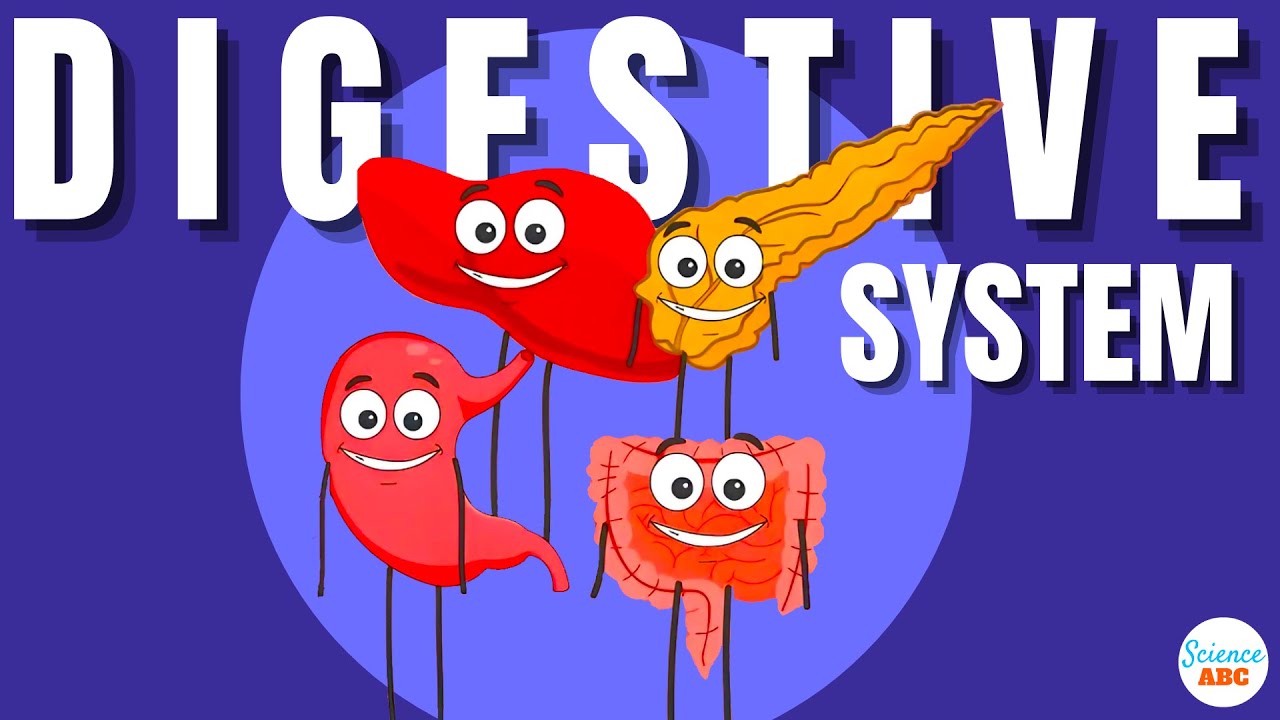Sistem Pencernaan Makanan Manusia (perjalanan makanan dari mulut sampai anus)
Summary
TLDRIn this educational video, teacher Ibu Lupita introduces the process of digestion, starting from the mouth where food is mechanically chewed and chemically broken down by enzymes like ptyalin. It then travels through the esophagus to the stomach, where it's further digested by gastric acid and enzymes like pepsin and renin. The partially digested food moves to the small intestine for nutrient absorption, aided by bile and pancreatic juice. Finally, the remaining food moves to the large intestine for water absorption and solid waste formation, ending at the rectum and anus for waste elimination.
Takeaways
- 🍽️ The digestive process begins in the mouth where food is mechanically broken down by teeth and chemically by enzymes like salivary amylase.
- 👅 The tongue in the mouth helps mix food to form a bolus, which is then swallowed.
- 🔒 The pharynx acts as a gateway to the esophagus, ensuring food goes down the digestive tract and not into the respiratory system.
- 🌊 Peristaltic movements in the esophagus push food into the stomach in a wave-like motion.
- 💪 The stomach contains muscles that contract to mechanically digest food and chemicals like gastric acid and enzymes (pepsin and rennin) to chemically digest it.
- 🥚 Pepsin in the stomach breaks down proteins into peptides.
- 🥛 Rennin converts caseinogen in milk into casein.
- 🕒 Food is churned in the stomach for about 3 to 4 hours until it becomes a semi-liquid called chyme.
- 🚀 Chyme is pushed into the small intestine (duodenum) where fat digestion is aided by bile from the liver and pancreas.
- 🌀 The small intestine has villi that absorb nutrients into the bloodstream.
- 🚰 The large intestine (colon) absorbs water, vitamin K, and compacts the remaining food into feces, which are then stored in the rectum before being expelled through the anus.
Q & A
What is the role of teeth in the digestion process?
-Teeth play a mechanical role in digestion by breaking down food into smaller pieces using the process of mastication.
What is the function of saliva in the mouth during digestion?
-Saliva contains enzymes like amylase that initiate the chemical digestion of food, particularly carbohydrates, and it also helps in forming a bolus for easier swallowing.
How does the tongue assist in the digestion process?
-The tongue helps in mixing food with saliva and forming it into a bolus, which is then swallowed. It also prevents food from entering the windpipe.
What is the role of the pharynx in the digestive system?
-The pharynx acts as a passageway for food from the mouth to the esophagus, ensuring that food goes to the stomach and not into the respiratory tract.
What is peristalsis and how does it function in the esophagus?
-Peristalsis is the wave-like muscle contractions that propel food from the esophagus to the stomach in a coordinated manner.
What is the role of the sphincter muscle at the end of the esophagus?
-The sphincter muscle at the end of the esophagus acts as a gate, allowing food to enter the stomach and preventing it from flowing back into the esophagus.
What are the main functions of the stomach in the digestion process?
-The stomach mechanically churns food and chemically digests it with the help of gastric juices containing enzymes like pepsin and hydrochloric acid (HCL).
What is the purpose of hydrochloric acid (HCL) in the stomach?
-Hydrochloric acid in the stomach helps to break down food, activates the enzyme pepsin, and kills harmful bacteria that may have been ingested with the food.
How does the enzyme pepsin contribute to digestion in the stomach?
-Pepsin in the stomach helps to break down proteins into smaller peptides called peptons.
What is the role of the enzyme renin in the digestion process?
-Renin is an enzyme that converts the protein caseinogen found in milk into casein, aiding in the digestion of dairy products.
How long does it typically take for food to be broken down in the stomach?
-Food is typically broken down in the stomach for about 3 to 4 hours until it is turned into a semi-liquid substance called chyme.
What is the role of the small intestine in the digestion process?
-The small intestine is where most of the digestion and absorption of nutrients occurs, with the help of bile from the liver and enzymes from the pancreas.
What is the function of the villi and how do they assist in absorption?
-Villi are finger-like projections in the small intestine that increase the surface area for absorption, allowing nutrients to be absorbed into the bloodstream.
What happens to the remaining undigested food as it moves into the large intestine?
-The undigested food moves into the large intestine where water, vitamin K, and electrolytes are absorbed, and the remaining waste is compacted into feces.
What is the final destination of the digested food in the body?
-The digested food ends up in the rectum and is eventually expelled from the body through the anus as feces.
Outlines

Cette section est réservée aux utilisateurs payants. Améliorez votre compte pour accéder à cette section.
Améliorer maintenantMindmap

Cette section est réservée aux utilisateurs payants. Améliorez votre compte pour accéder à cette section.
Améliorer maintenantKeywords

Cette section est réservée aux utilisateurs payants. Améliorez votre compte pour accéder à cette section.
Améliorer maintenantHighlights

Cette section est réservée aux utilisateurs payants. Améliorez votre compte pour accéder à cette section.
Améliorer maintenantTranscripts

Cette section est réservée aux utilisateurs payants. Améliorez votre compte pour accéder à cette section.
Améliorer maintenantVoir Plus de Vidéos Connexes
5.0 / 5 (0 votes)






